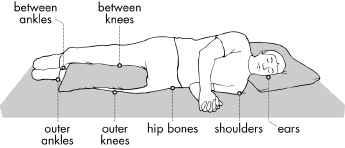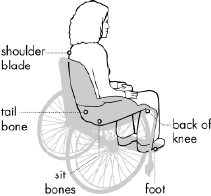SCI Pamphlets: Staying Healthy after a Spinal Cord Injury
The pamphlet series:
• Taking Care of Pressure Sores
• Maintaining Healthy Skin (Part I)
• Maintaining Healthy Skin (Part II)
• Taking Care of Your Bowels: The Basics
• Taking Care of Your Bowels: Ensuring Success
Maintaining Healthy Skin - Part 2
[Download this pamphlet: “Maintaining Healthy Skin: Part 2” (1.37MB)]
Skin inspection
The only way to know if your skin is healthy and intact is to look at it regularly. In areas where sensation (feeling) is decreased, skin inspection is essential and should become a habit. Plan it as a part of your regular daily routine, during a time when you are undressed anyway — such as after a shower, before dressing in the morning or after undressing in the evening. Daily skin inspection is necessary.
If you are unable to see some parts of your body, use a mirror or teach another person to check your skin for you. Long handled mirrors and other specially designed mirrors are available. Check all of your bony prominences, or areas where the bones protrude slightly below the skin (see illustrations below for the locations and names of these areas).



What to look for
Look for any reddened areas, rashes, cuts, bruises, scrapes, or indentations from seams or elastic binding. Check also for blisters, bumps, insect bites, dry flaky skin or pimples. Feel your skin for any thickening or change in texture, especially over bony areas. Check toenails for any redness or pus formation around the end of the nail.
Whenever you notice a problem, try to figure out its cause and make any changes necessary to prevent further problems. The first step in curing any skin problem is to eliminate the cause.
Preventing skin injuries
- PRESSURE RELEASES
Are you changing your position often enough to relieve pressure over bony prominences?
In both bed and wheelchair, change your position according to your skin tolerance. (For information on establishing skin tolerance, see our “Pressure Sores” pamphlet.) Pressure releases in a wheelchair can be done by pushing straight up, leaning side to side, bending forward over your knees, reclining the seat of your electric wheelchair or having someone tilt you back in your manual chair. Always use your wheelchair cushion.
In bed, body parts can be padded with pillows to keep bony prominences free of pressure. Place a pillow between the knees while sleeping on your side to prevent skin-to-skin contact and increase air circulation between the legs (see illustration above). Get into the habit of checking your body position for correct alignment and pressure-free positioning of bony prominences.
- EQUIPMENT
Are you using the best equipment? Does it fit you properly? Here are some concerns:
- Wheelchair — Does it support your back? Are your footrests the right height? Are you using the best wheelchair cushion?
- Bed — Are you using a good mattress?
- Leg bags — Are the straps too tight?
- External catheters — Is the correct size being used? Is it being changed frequently enough?
- Splints/Braces — Do they fit properly? Do you do skin checks after wearing them?
- Wheelchair — Does it support your back? Are your footrests the right height? Are you using the best wheelchair cushion?
- TEMPERATURE
Extremes of temperature call for extra caution in protecting your skin:
-
Heat — Avoid sunburn by covering up or using sunblock. Don’t put plates of hot food on your lap without protecting your skin. When riding in a car, keep your feet away from the heat outlet and check vinyl seats before you sit on them to make sure they aren’t too hot. Any exposed pipes in your kitchen or bathroom sink should be wrapped to protect your legs from burns. When you go camping, protect your feet by sitting a safe distance from the campfire.
-
Cold — Be sure to dress warmly to prevent frostbite if you are out in cold weather for long periods of time. Dressing in layers of clothing will provide extra warmth. Avoid putting frozen foods on your lap.
-
Fever — Your skin tolerances can change due to the increased body temperature that occurs with a fever. You will need to shorten the time you lay in one position. Check skin extra carefully.
- BODY WEIGHT
- Too much — Being overweight can cause increased pressure on bony prominences. Delayed healing may occur because there are fewer blood vessels in fat tissue.
- Too little — Excess pressure over bony prominences may occur because there is less padding (muscle and fat) over these surfaces. In addition, underweight persons may lack the proper nutrition to maintain healthy skin.
- Too much — Being overweight can cause increased pressure on bony prominences. Delayed healing may occur because there are fewer blood vessels in fat tissue.
- CLOTHING
Proper fit is important. Avoid sitting on seams and back pockets, and always check your skin carefully after wearing new shoes or clothing.
- Too loose — Loose clothing can form wrinkles that put pressure on your skin.
- Too tight — Overly tight clothing can hinder circulation.
- ALCOHOL
Over-indulgence in alcohol - or any other drug - may interfere with attention to your personal care needs. For example, while under the influence you might forget to turn yourself, or be too weak to transfer yourself properly.
- STRESS
Stress and depression can have a similar effect by causing you to lose interest in your personal care and pay less attention to your skin and general health.
- SPASTICITY
Spasticity may cause your arms and/or legs to bump against an object, or to fall off your armrest or footrest, and be injured. Spasms may cause your skin to rub against something (for example, the sheets on your bed), which could produce an open sore.
University of Washington-operated SCI Clinics:
Harborview Medical Center
Rehabilitation Medicine Clinic
325 9th Ave., Seattle WA 98104
Spinal Cord Injury Clinic nurses: 206-744-5862
University of Washington Medical Center
Rehabilitation Medicine Clinic
1959 NE Pacific, Seattle WA 98195
Spinal Cord Injury Clinic nurses: 206-598-4295






